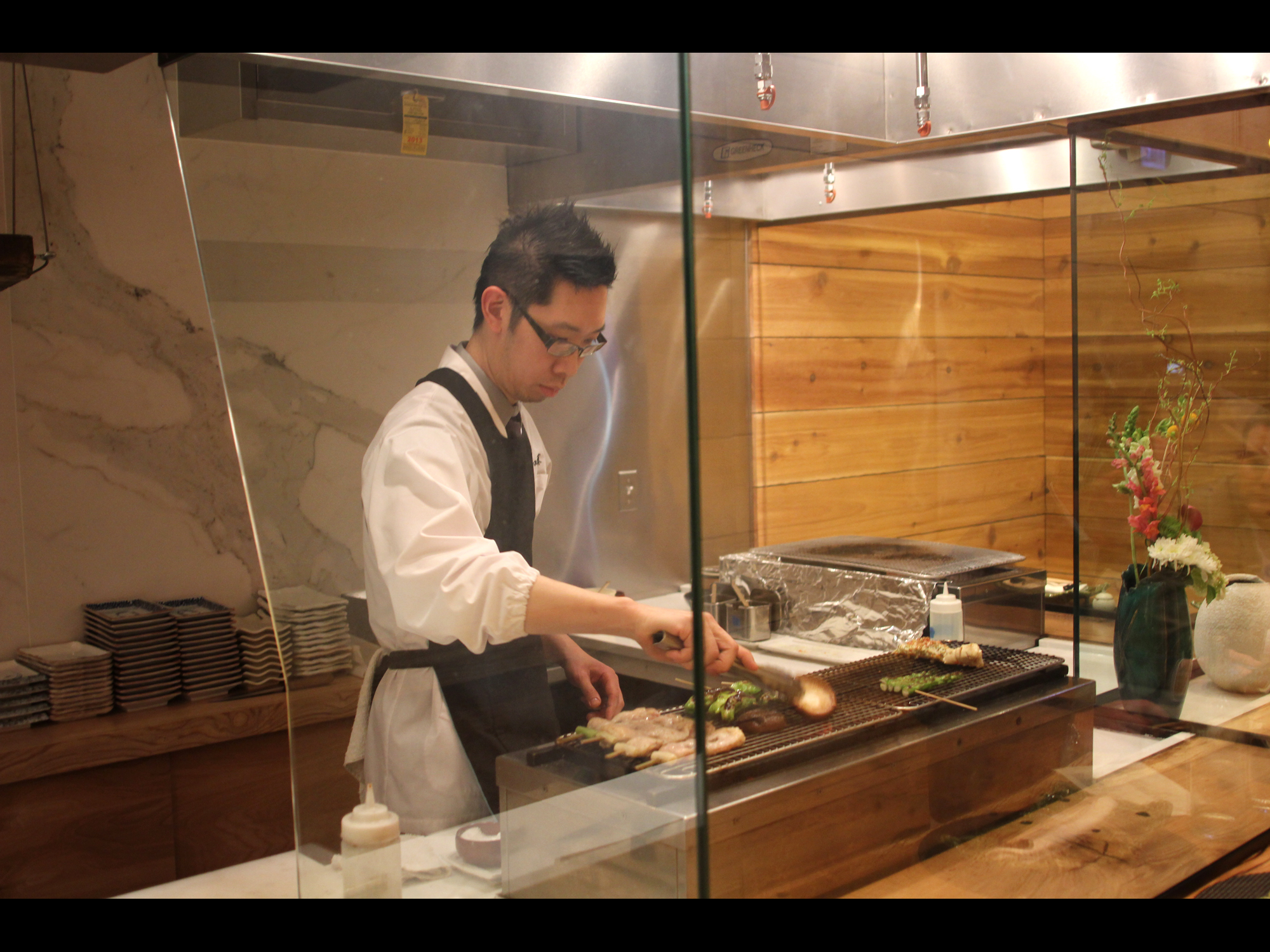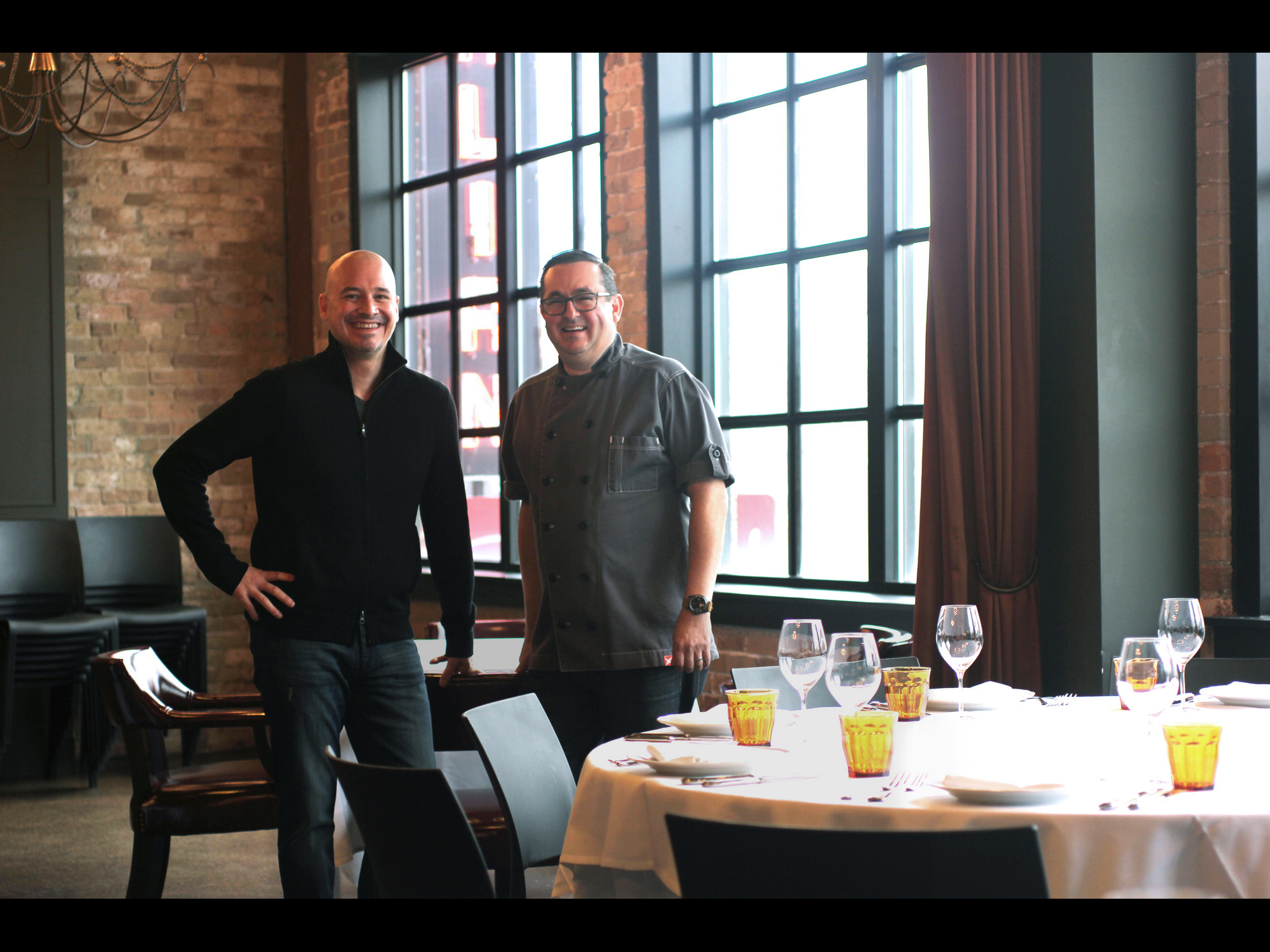SAY THE NAME MIA FRANCESCA and you immediately get a picture of one of Chicago’s most successful restaurant mini-empires, twenty locations serving high quality, very accessible Italian food. At 25 years in, chef and co-founder Scott Harris, who started it at 3311 N. Clark St. in early 1992 with then-wife Francesca and partners Michael Noone and Terry Alexander, has much to be proud of, and more on the horizon.
He’s also nostalgic for the way things were. Harris isn’t sorry to have built an empire, but he’s conscious of the incidental pleasures (for diners and owners) of the small and scrappy restaurant, and tries to keep at least some of that spirit alive in his chain.

Scott Harris
When the original Mia Francesca made its debut in the 1930s storefront that had been Ideal Candies, Harris admits he didn’t have a business plan. Trained as a French chef, he’d worked all over—at the Signature Room at the 95th, Ambria, Sole Mio, Chez Jenny, and in St. Croix, among other places—but says he really fell in love with Italian food as chef at Franco Zalloni’s Trattoria L’Angolo di Roma. That’s also where he met Noone and Alexander, who still are partners in FRG though they’ve also gone on to other things (notably, Alexander as one of the partners in One Off Hospitality Group).
By that time, Harris knew he wanted his own place. After his father, a carpenter, died in a car accident, he pooled his $60,000 share of the life insurance with equal sums from the two partners, money from their parents, and about $27.000 from his grandmother to come up with the $260,000 or so needed to open Mia Francesca (not counting the building’s purchase a few years later). “We didn’t know if Ideal Candies’ owner Peter Vasilakos—we called him ‘Sweet Tooth Pete’—would choose us,” he says. “There were two other contenders, and he asked us each what we planned to do with the space. We said we weren’t going to change much because we loved it the way it was, and I think that sealed a deal that would cost $1-million today.”
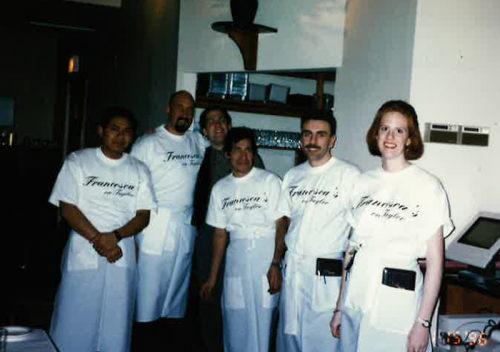
Staffers at Mia Francesca on Taylor in 1996, two of whom are partners in the company today: Patrick Barnes (third from left) and Helmut Schadinger (fifth from left).
Harris acknowledges that he lifted a lot of his casual concept from Zalloni’s Trattoria Pizzeria Roma, which had opened in 1985. Reservations weren’t taken, and lines often stretched out the door. Tables topped with white cloths and butcher paper were crammed close together. The music was loud, and the atmosphere was noisy, so noisy that restaurant critics complained. Little juice glasses were used for wine.
People would wait outside, even in the cold, for 45 minutes until the restaurant opened at 5 p.m. If I hadn’t been so young and dumb, I would have started opening at 4.
The menu, complete with spelling errors, was hand-written every day on a sheet of paper and xeroxed. In addition to pizzas and antipasti, such as top-selling carpaccio with a different topping daily, fried calamari, and asparagus salad, it had half-a-dozen pastas, three fish, roast chicken, and a veal, pork, chicken breast, or lamb (occasionally) secondi or two. A few daily specials were on a separate card. “We didn’t serve beef then,” Harris says. “I’m not sure why. I guess because it wasn’t on Roma’s menu.”
Harris adds, though, that one very important feature distinguished his trattoria from Zalloni’s: freshness. “Franco cooked like his mother did in Italy and used a lot of frozen product,” he says. “We wanted to make it better, so everything was fresh every day, we incorporated our own touches, and we undercut everyone else’s prices. Pastas started at $6.95, veal at $14.95. Our food cost was 40 percent, but I didn’t care because we were packing them in.”
About a year-and-a-half after Mia Francesca opened, Harris converted the two-car garage in back to a little bar and furnished the patio for outdoor dining. The upstairs became a party room several years after that. He started taking reservations in the late 1990s but still wonders about something he didn’t do before that: “People would wait outside, even in the cold, for 45 minutes until the restaurant opened at 5 p.m. If I hadn’t been so young and dumb, I would have started opening at 4,” he confesses.
THE IMPETUS FOR THE SECOND location, La Sorella di Francesca in downtown Naperville, came from customers who suggested the suburb. That’s also where the practice of giving each location a variation on the Francesca name started, though Harris says that if he had it to do over, he’d just call every restaurant Mia Francesca. “My partners and I drove all the way out there on Ogden Ave. one day, and after seeing several strip-mall locations, we decided we needed to be downtown,” he says. “Once we saw the building that had been City Hall, we signed a lease within a week and opened in February 1994.”
Except for three more in the city and one in Raleigh, North Carolina, all the other current Francescas are in the suburbs. “There’s no real rhyme or reason except that the suburbs have been very good to us. Customers accept us as their go-to neighborhood Italian restaurant,” Harris says. “It’s more expensive to open in the city and so saturated with choices that we probably won’t do more unless it’s a new concept. But we’re looking hard at Algonquin for a Francesca’s, and Lincolnshire, and a couple of other suburbs.”
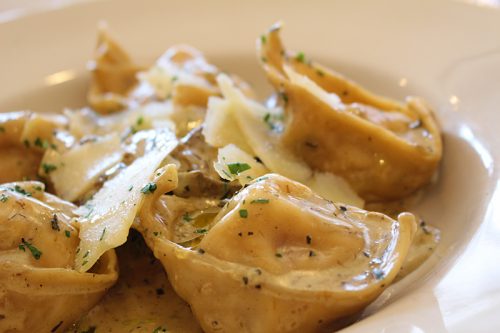
Tortellacci al Funghetto
One of the changes Harris regrets most is the evolution of the menus. When the group had half-a-dozen restaurants, the switch was made from writing them daily to weekly because there weren’t enough employees with decent handwriting to keep up. Then they went to every two weeks, and finally monthly. Now the menus are all printed, though the printing looks like handwriting. “I hate them,” Harris says. “They used to be much more like the menus in Italy with the misspellings, but my corporate team has forced me to adjust. At least the basic format is the same—though there are five-to-seven specials now rather than two or three.”
The morphing menu also reflected the shift in purchasing patterns, which bothers Harris even more. “Purchasing power efficiencies are necessary for a restaurant group, but I’m a chef, and I like the creative freedom of buying ingredients every day and never knowing quite what you’re going to get,” he explains. Still, he does his best to switch out the pastas frequently, though the spinach ravioli with four-cheese cream sauce has stayed on the menu since the beginning because people love it, and other original choices—rigatoni alla Siciliana with spicy roasted eggplant, penne with fresh mozzarella and tomato-basil sauce, linguine all’Arlecchino with seafood and spicy cherry tomato sauce—are available on request. Steak, added years ago due mostly to suburban demand, has become a mainstay.
Harris still is mad that he bowed to customer pressure—especially from the suburbs—and started using stemware around 2000. “People don’t want to drink a $100 bottle of wine from juice glasses, but some of the rustic casualness is lost,” he says. He’s also sorry he changed the servers uniforms and stopped giving free fruit at the end of dinner, because his FRG partners, who now number more than 20, said it was too expensive. Nowadays, customers are asked if they want bread rather than it arriving automatically, but that’s because in the last few years many had been turning it down.
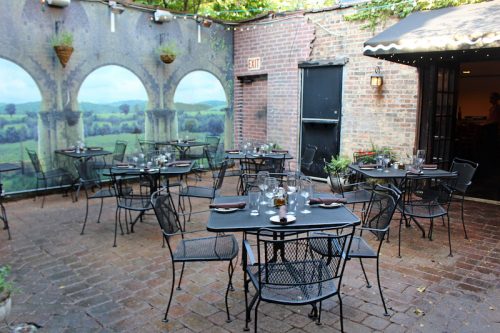
Patio on Clark Street, with iItalian mural
FRG’S EXPANSION PLANS HAVE BEEN modified, too, but Harris is comfortable about that. Mia Francesca in Scottsdale, AZ, closed in 2013, and the restaurants in San Diego, CA, and Madison, WI, shuttered earlier this year. Now the focus is on the Midwest: Milwaukee, Indianapolis, Nashville, St. Louis, Kansas City, the Minneapolis-St. Paul area. “Last time we started with far flung locations, which wasn’t too smart,” he says. “This time we want to be able to hop on a plane and get to one of our restaurants in 45 minutes.”
Since 2010, the group also has grown to include five outposts of Davanti Enoteca (three in the Chicago area, two in San Diego), five Glazed and Infused donut shops in Chicago, Fat Rosie’s Taco and Tequila Bar in Frankfort, and Disotto in Highwood. In addition, Hillgrove Tap, the sports bar next to the Davanti Enoteca in Western Springs, may be replicated in Winnetka with a different name.
The original Mia Francesca’s main dining room is being remodeled this fall in honor of the 25th anniversary, as are the restaurants on Taylor and Chesnut streets and the one in St. Charles. (Say goodbye to the butcher paper and white tablecloths.) All the locations will be revamped over the next three years.
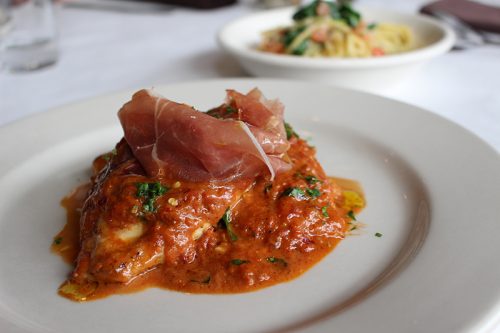
Pollo Salvia
Harris says he’s going to update the menu with more vegetables and fish, because that’s what people are eating, as well as more antipasti, stuffed fresh pastas, and steaks (which remain very popular). He’s been interviewing top chefs from all over the country (plus two in Rome and one in Hong Kong)–he won’t say who—with an eye to hiring four-to-six of them to bring their ideas and themselves here. Another idea he’s floating is introducing a simplified Italian menu like the one at Disotto with “greatest hits” from all of his concepts.
At the same time, he’s surveying the 135,000 regulars on Francesca’s mailing list to find out if they want to keep the menu the same, or change it to smaller portions with lower prices and more vegetables and fish. “So far, customers who are older than 45 want it to stay the same, while those who are younger want to see changes,” he says.
People on the mailing list also benefit from blast emails about anniversary specials. While the big party was on Mia Francesca’s opening day, February 13, every other Monday throughout the rest of the year, three of the Francesca’s restaurants will roll back their prices to 1992. The emails say which three. “We’ve been having two-hour waits,” Harris says. “It’s just like the old days.”
Anne Spiselman is a freelance writer who has covered food, wine, and culture for decades. She’s a frequent contributor to Crain’s Chicago Business and Edible Chicago and has written for most local publications and some national ones.
Latest
Join the Discussion
After you comment, click Post. If you're not already logged in you will be asked to log in or register with Disqus.





